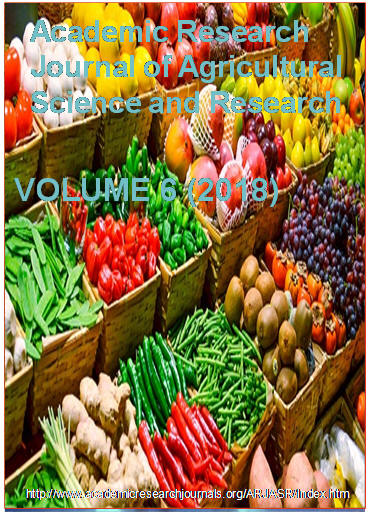| ARJASR |
Academic Research Journal of
Agricultural Science and Research |
||||||||||||||||||||||
|
Academic Research Journal of Agricultural Science and Research Vol. 6(6), pp. 305-311. July, 2018. ISSN: 2360-7874 DOI: 10.14662/ARJASRD2018.032 Full Length Research Response of Maize (Zea mays L.) to Supplementary Irrigation in Raya valley, Northern Ethiopia
Yemane Mebrahtu1*and Habtamu Tamiru1
1*Ethiopian Institute of Agricultural Research (EIAR), Mehoni Agricultural Research Centre, Ethiopia 1 Ethiopian Institute of Agricultural Research (EIAR), Mehoni Agricultural Research Centre, Ethiopia Corresponding author's email: yemanemebrahtu653@yahoo.com
Accepted 29 July 2018
In the Raya Valley of Ethiopia, farmers mostly rely on rainfall for crop production. The erratic nature of rainfall causes frequent crop failures and alternative technologies to increase grain maize production under rainfed systems are right away needed, considering the low grain yield in small-scale farming. Supplemental irrigation, fertilizer application and tillage methods are valuable available farming technologies. A field experiment was carried out at Mehoni Agricultural Research Center, Raya Valley of Ethiopia, during 2013/14 to 2015/16 for the consecutive three season with objectives of to maximize crop productivity of rainfed agriculture, to determine the effect of supplementary irrigation on crop yield, to determine crop water requirement and to determine water use efficiency. The experiment were laid out in a random complete block design (RCBD) consisting of eight levels of irrigation treatment (full or 100%, 75%, 50%, 25%ETc, one SI at flowering stage, one SI at grain filing, two SI at flowering and grain filing stage and a control treatment (Rainfed agriculture) with three replications. Longer days to maturity, highest plant height and ear length was recorded when 100% ETc irrigation level applied and earlier day to maturity, smallest plant height and ear length were recorded with non-supplementary irrigation (rain fed). The highest grain and biomass yield were obtained at 100% ETc supplementary irrigation depth gives 23.2% and 24.4% greater than the control respectively. In terms of crop water use efficiency, the rainfed gave the highest irrigation water use efficiency and crop water use efficiency which was significantly superior to all other treatments. Therefore, it can be concluded that in the study area the rain fed amount were very inadequate and limited, supplementary irrigation with 100% ETc were help to increase crop productivity and minimize crop failure due to the low rainfed and decrease the deficit of food in the study area.
Keywords: Crop water use efficiency, Maize, Rainfed, Supplemental irrigation
How to cite this article: Mebrahtu, Y., Tamru, H., (2018). Response of Maize (Zea mays L.) to Supplementary Irrigation in Raya valley, Northern Ethiopia. Acad. Res. J. Agri. Sci. Res. 6(6): 305-311
|
|
|||||||||||||||||||||
